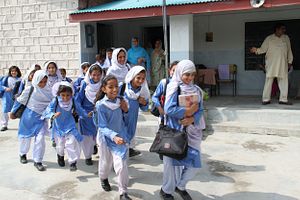The right to education is considered to be a fundamental human right. It’s the state’s responsibility to ensure at least basic education for all children. Article 25A of Pakistan’s 1973 constitution says that “The state shall provide free and compulsory education to all children.” However, the central question remains: Is the government investing its resources effectively to meet challenges faced by the primary and secondary education sector?
One of the key challenges that Pakistan’s education sector faces deals with ensuring student’s enrollment at all levels (elementary, secondary and higher education). According to some reports, more than 20 percent of the country’s young population does not attend school. Moreover, the problem of nonattendance, lack of infrastructure, gender disparity and quality of education also remain a major challenge. According to Pakistan’s National Education Census (NEC) report which was carried under the supervision of the UNESCO, “Pakistan is still a long way from achieving universal primary enrollment.”
Compounding these concerns is the issue of untrained teaching staff and vacant teaching posts at public institutions, particularly at the primary and secondary levels. During the past few years, the government of Punjab has sought to increase the overall number of teachers in the province. In 2017 alone, the government is looking to recruit 80,000 teachers as part of its broad campaign to strengthen the school education network in the province. Despite the government’s recent efforts to increase the overall number of teachers in the province, independent research institutes note that the province still remains far behind in terms of providing the necessary teaching staff across the province. According to the Academy of Educational Planning and Management (AEPMA) “around 15 percent of the total schools in Punjab have only one teacher teaching multiple grades at public schools.”
Another report shows that a significant number of schools in Pakistan lack adequate facilities and infrastructure to improve the teaching environment. For instance “9 percent of primary schools do not have a blackboard, 24 percent do not have textbooks available for the children and 46 percent do not have desks for the students. Only 36 percent percent of the public primary schools in the country have electricity.”
While Punjab’s overall performance indicators continue to rise, the province still continues to see a decline in the area of learning outcomes. “Overall, the biggest challenge is that of quality education. Learning outcomes remain weak across the country,” argues Musharaf Azidi of the Alif Aillan, a nonprofit organization working in the field of education in Pakistan since 2013. According to a Alif Aillan report, “While [Punjab’s] focus rightly continues on access, gender parity and retention, education quality represents the biggest long-term weakness in the system.” The report further notes that “low-quality education drags the entire education system down and this represents a growing problem.” While assessing some of the strategic issues related to the quality of education in Punjab, the province’s own long-term strategic plan underscores that “there are no definitions or benchmarks for quality of education specified by the School Education Department (SED). Lack of relevant indicators and data does not allow for an accurate and comprehensive assessment of the quality of education provided in schools.” A curriculum which focuses on meaningful learning should be at the centerpiece of a student’s learning experience.
The province’s current reform process has some excellent initiatives but its impact will not be cumulative without the presence of proper linkages between smart investment and effective learning outcomes. The argument that Punjab needs to invest more into education doesn’t offer a practical and sustainable solution to the issues at hand. Pakistan is already investing a lot of money in the education sector. “The danger of doubling the education budget without a plan is that it will go straight into salaries,” argues Nadia Naviwala. She further notes that “schools in Pakistan do better when they spend efficiently.”
Irrespective of the impending challenges, the province of Punjab continues to show signs of improvement. There is no denying that the current government in the province has come a long way in terms of laying the necessary groundwork to make essential and gradual interventions in areas related to learning outcomes and the quality of education.
The access to education can only be improved if the province’s government focuses and addresses underlying strategic challenges ranging from the quality of education to its relevance to the job market. For one thing, the government needs to eliminate the culture and curriculum that focuses primarily on “rote learning.” Certainly, the efforts which the provincial government has made over the past few years are likely to create more opportunities for Punjab to become not only a province with a skilled workforce but also a region that can revolutionize Pakistan’s education sector.

































